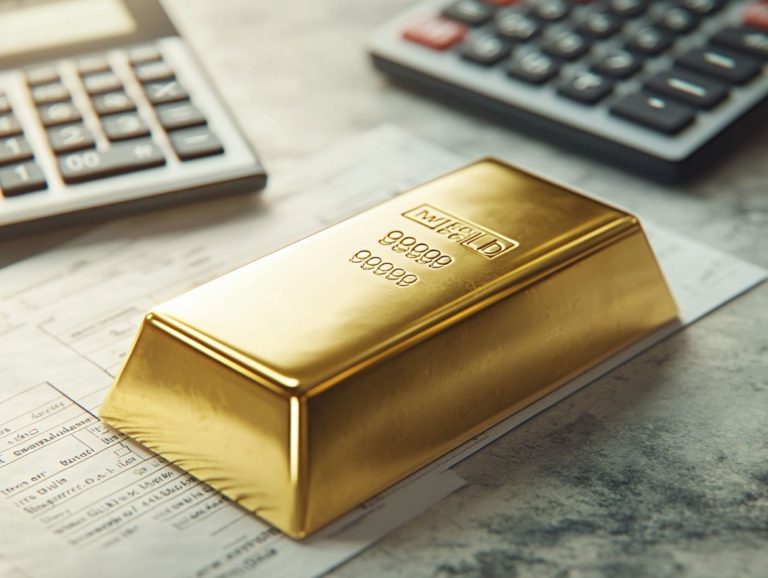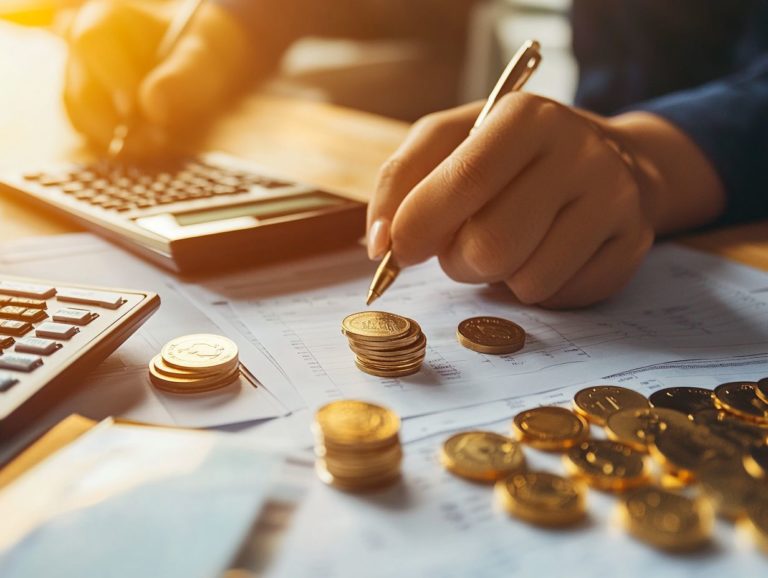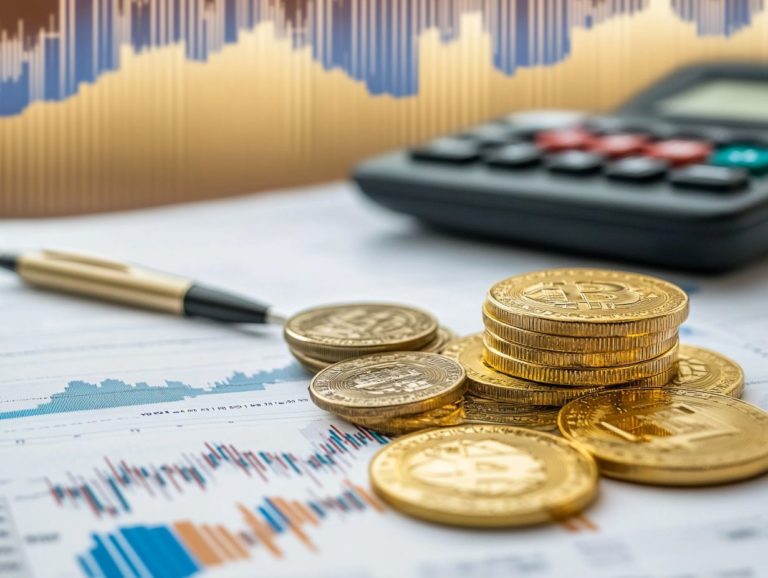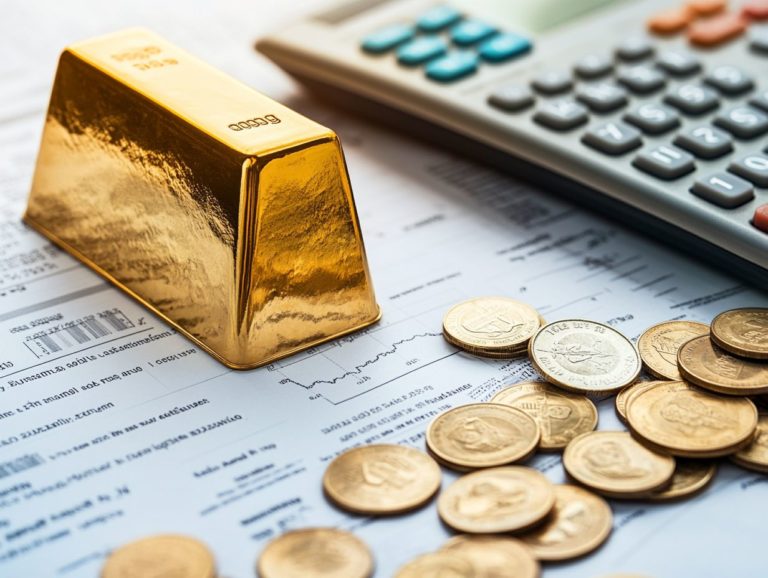The Tax Landscape for Precious Metals in the Next Decade
The precious metals market is undergoing a dynamic shift, shaped by various economic and political factors.
As prices fluctuate, understanding the current trends is essential for investors. Navigating the tax implications tied to these investments adds another layer of complexity.
This article covers key aspects of the precious metals landscape, including capital gains taxes and effective strategies to minimize tax liabilities.
Looking ahead, it offers insights into how taxation may evolve over the next decade. Equip yourself with the knowledge necessary to optimize your investments.
Contents
- Key Takeaways:
- The Current State of the Precious Metals Market
- Factors Affecting the Tax Landscape for Precious Metals
- Tax Implications for Investing in Precious Metals
- Strategies for Minimizing Taxes on Precious Metals
- Future Predictions for Taxation of Precious Metals
- Frequently Asked Questions
- What is the current tax landscape for precious metals?
- Will the tax landscape for precious metals change in the next decade?
- How will these potential changes affect investors in precious metals?
- Are there any countries that are particularly favorable for investing in precious metals from a tax perspective?
- What should investors keep in mind when it comes to taxes and precious metals?
- Is it possible to invest in precious metals tax-free?
Key Takeaways:
- Precious metals are rising in price and demand, capturing investor interest.
- Stay informed about economic and political factors that shape tax implications.
- Understand capital gains taxes and reporting requirements before investing.
The Current State of the Precious Metals Market
The current landscape of the precious metals market is marked by price fluctuations and various trends influenced by economic factors, investor sentiment, and geopolitical developments. Precious metals like gold, silver, platinum, and palladium are increasingly seen as safe haven assets, especially during periods of market volatility and economic uncertainty.
These assets provide a sense of security and act as a hedge against inflation, attracting investors seeking stability amid changing economic conditions.
Overview of Prices and Trends
The prices of precious metals such as gold, silver, platinum, and palladium have shown notable fluctuations over the past year, shaped by various economic conditions and trends. As you navigate these changes, remember that demand levels play a vital role in influencing market values.
Historically, during times of economic uncertainty, there is often an uptick in investment in these prized commodities, as they serve as a safe haven. Additionally, industrial applications especially in technology and automotive sectors further influence pricing dynamics. The market is also complicated by fluctuations driven by geopolitical events and currency values.
For those closely monitoring the market, maintaining accurate documentation is essential for informed investment decisions, positioning you to seize opportunities amid the ever-evolving landscape.
Factors Affecting the Tax Landscape for Precious Metals
The tax landscape for precious metals investments is intricate and significantly shaped by various implications, including adherence to IRS regulations and insights from tax professionals. As an investor, you need to navigate the complexities of capital gains tax, particularly when selling assets like gold, silver, platinum, and palladium.
Understanding these nuances is crucial for effective estate planning and for minimizing any potential financial penalties from tax evasion.
Economic and Political Influences
Economic uncertainty and political influences greatly shape the tax implications surrounding your precious metal investments, impacting both market behavior and your investment strategies.
As global markets fluctuate in response to geopolitical tensions and economic instability, you may find yourself reassessing your positions in precious metals. For instance, rising inflation rates might lead you to view gold as a safe haven, while changes in foreign tax laws could introduce increased reporting obligations. It’s crucial to understand the tax obligations of precious metals to ensure compliance and optimize your investment strategy.
Shifting political landscapes often bring about new compliance tax requirements that change how you calculate and report profits from these investments.
Ultimately, grasping the nuances of these factors is crucial for effectively navigating the precious metals market and optimizing your investment returns.
Stay proactive in your investments. Knowledge is power!
Tax Implications for Investing in Precious Metals
Investing in precious metals comes with substantial tax implications. This is especially true regarding taxes on profits when you sell. Understanding these implications can significantly impact your tax liability and shape your overall investment strategy.
By grasping the various tax obligations associated with selling gold, silver, platinum, and palladium, you position yourself to leverage effective tax-saving strategies. Understanding the tax landscape for precious metals in 2024 will help ensure compliance with IRS regulations.
Capital Gains Taxes and Reporting Requirements
Capital gains taxes, or taxes on profits when you sell, are a crucial aspect for you to consider as an investor in precious metals. Understanding the reporting requirements can greatly influence your overall tax obligations.
It’s important to recognize the difference between long-term and short-term capital gains. The tax rates for these categories vary significantly. Long-term gains, from assets held for more than a year, typically enjoy lower tax rates. In contrast, short-term gains, from assets held for one year or less, are taxed at ordinary income rates.
To accurately report these gains, you’ll need to use specific forms:
- Form 1099-B: summarizes proceeds from broker transactions
- Form 8949: provides detailed documentation of your transactions
By keeping meticulous records of these transactions, you ensure compliance with IRS regulations. This also positions you to make informed financial decisions in the future.
Strategies for Minimizing Taxes on Precious Metals
Implementing effective strategies to minimize taxes on your precious metals investments can enhance your overall investment performance. This aligns seamlessly with your long-term financial goals.
Utilizing tax-saving methods, such as tax-loss harvesting, allows you to offset capital gains and reduce your tax liability. This approach not only complies with tax laws but also optimizes your investment strategy for maximum benefit.
Tax-Loss Harvesting and Other Techniques
Tax-loss harvesting is a powerful strategy that gives you the power to offset capital gains with capital losses. This effectively minimizes your overall tax liability when investing in precious metals.
By strategically selling underperforming assets, you can realize losses that help counterbalance any taxable gains from your more profitable investments. For instance, if you sell a precious metal that has declined in value, you can apply that loss to offset gains from other investments. This reduces your taxable income.
This approach supports effective portfolio management. It also elevates your investment strategies by fostering a more tax-efficient trading method.
However, it’s essential to comply with IRS regulations. Be cautious of penalties linked to improper reporting, such as the wash-sale rule. This rule may prevent you from claiming a loss if you buy the same asset back too quickly.
Future Predictions for Taxation of Precious Metals
Future predictions about the taxation of precious metals indicate that changing IRS regulations and economic conditions will profoundly affect the investment landscape. This will also have tax implications for you as an investor in these safe haven assets.
Expert Opinions and Forecasts
Expert opinions and forecasts about the future of taxation in the precious metals market underscore the importance of staying informed. Adapting your investment strategies accordingly is crucial.
With various changes looming, such as potential increases in capital gains taxes and the introduction of new regulations, grasping these shifts becomes essential for maintaining a robust portfolio. Financial experts point out that fluctuations in tax policies could significantly impact the demand for gold, silver, and other precious metals. To navigate these complexities, it’s important to understand collectibles tax on gold and silver.
As an investor, this means actively drawing on insights from market analysts. Stay updated on government announcements and reevaluate your asset allocations. This will help shield against potential tax liabilities.
By doing so, you can better position yourself to seize opportunities while effectively mitigating risks in the ever-evolving investment landscape.
Frequently Asked Questions
Keep up with the latest tax changes to safeguard your investments!
What is the current tax landscape for precious metals?
The current tax landscape for precious metals varies based on the specific metal and country. Most countries impose a capital gains tax on profits from selling precious metals. Some also have additional taxes like VAT or sales tax.
Will the tax landscape for precious metals change in the next decade?
The tax landscape for precious metals is likely to change in the next decade. Governments regularly review tax laws, and there is growing interest in regulating the buying and selling of precious metals. This may lead to changes in tax rates or new taxes being introduced.
How will these potential changes affect investors in precious metals?
The impact of potential tax changes on investors will depend on the specific adjustments made. Increased taxes may decrease the profitability of investing in precious metals, while more favorable tax laws could enhance its appeal as an investment option.
Are there any countries that are particularly favorable for investing in precious metals from a tax perspective?
Yes, a few countries are known for their favorable tax laws regarding precious metals. Switzerland, Singapore, and the United Arab Emirates have little to no capital gains tax on precious metal investments.
What should investors keep in mind when it comes to taxes and precious metals?
Stay sharp! It’s crucial for investors to understand the tax implications of their investments in precious metals. Keep informed about changes in tax laws and consult a financial advisor or tax professional to ensure compliance with relevant regulations.
Is it possible to invest in precious metals tax-free?
Yes, you can invest in precious metals tax-free in certain situations. For instance, holding precious metals in a tax-sheltered account (like a self-directed IRA a retirement account allowing more control over investments) may defer or even eliminate taxes on your investments. Don’t wait consult a financial advisor today to get ahead!














